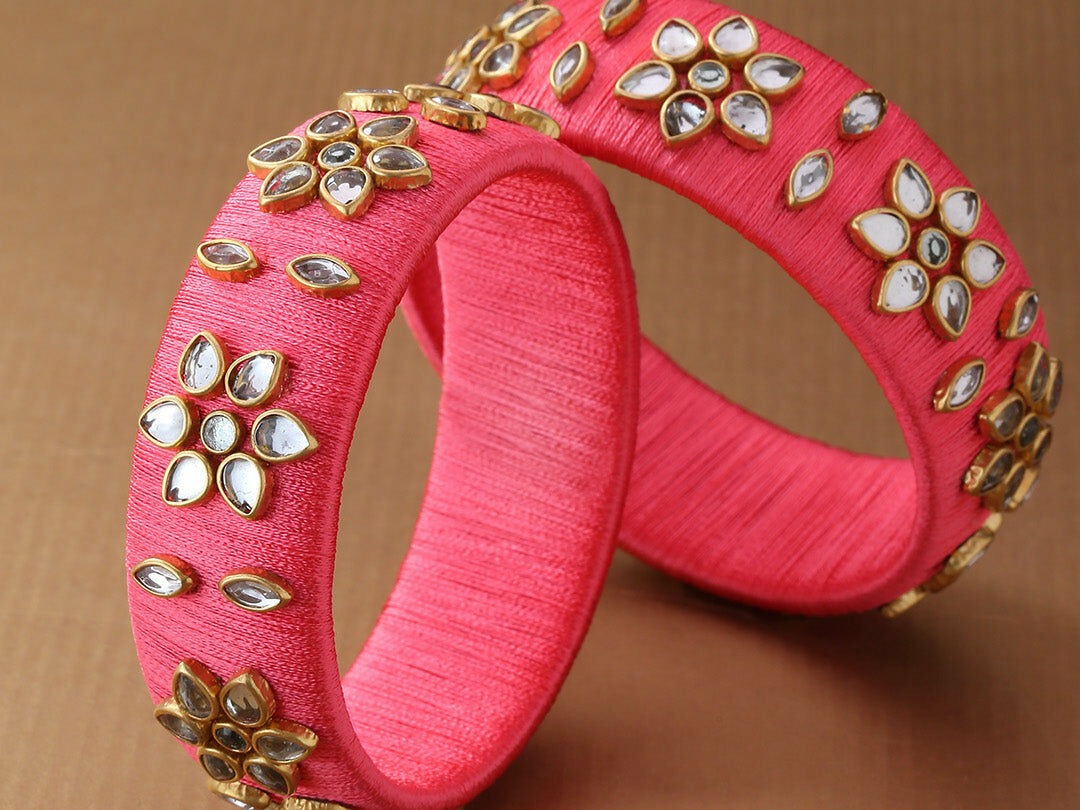Bangles are more than just accessories in India—they are timeless symbols of tradition, culture, and feminine grace. From the bride’s chooda in the north to the vibrant glass bangles of Hyderabad, bangles hold a special place in Indian fashion and heritage. In this comprehensive guide, we explore the fascinating history of Indian bangles, the regional styles, their cultural significance, and how you can shop for the perfect pair—whether traditional or contemporary.
The Cultural Significance of Bangles in India
Bangles are worn across India by women of all ages and backgrounds. They are traditionally considered a sign of prosperity, marital status, and feminine energy. In many communities, the jingling of bangles is believed to ward off negative energies and bring positivity to the wearer.
Bangles and Marriage
For Indian brides, bangles are among the most symbolic items of bridal attire. In states like Punjab, brides wear red and white bangles called chooda, while in Bengal, the shakha pola—white conch shell and red coral bangles—are part of the bridal ritual. The breaking of a bangle is often seen as inauspicious, symbolizing fragility and loss.
Festivals and Daily Wear
Women also wear bangles during festivals like Karva Chauth, Diwali, Teej, and Navratri. Color coordination with sarees, salwar suits, or lehengas is common, and bangles are often chosen based on occasion, age, and mood.
Historical Origins of Bangles in India
Archaeological findings suggest that bangles have been a part of Indian culture since the Indus Valley Civilization (around 2600 B.C.). Terracotta bangles, shell bangles, and even metal bangles have been found in excavations. Ancient texts and sculptures, including those in temples, also depict women adorned with bangles, highlighting their age-old appeal.
Popular Traditional Bangle Styles by Region
1. Lac Bangles (Rajasthan & Bihar)
Made from lacquer, these bangles are colorful, vibrant, and often embellished with mirrors and stones. They’re popular during weddings and festivals.
2. Glass Bangles (Hyderabad & Maharashtra)
These fragile yet dazzling bangles come in a rainbow of colors. A stack of these bangles can make a melodic jingling sound, which is considered auspicious.
3. Gold Bangles (Kerala, Tamil Nadu)
Gold bangles are considered a mark of wealth and social status. In South Indian weddings, brides are adorned with multiple gold bangles passed down through generations.
4. Ivory and Bone Bangles (Rajasthan)
Traditionally worn by Rajasthani brides, these bangles are carved and often paired with red lac for striking contrast.
5. Metal & Brass Bangles (Punjab & Gujarat)
Heavier and more durable, these are often engraved or embellished with traditional motifs. They are both decorative and meaningful.
6. Shell Bangles (West Bengal)
These include the shakha (conch shell) and pola (red coral), which are worn by married Bengali women.
7. Wooden Bangles (North-East India)
Crafted from various woods and sometimes painted or carved, these bangles are earthy and eco-friendly.
Styling Bangles: Modern Meets Traditional
Today’s women often blend traditional bangles with modern fashion. Here’s how to wear them for different occasions:
Daily Wear:
- Choose lightweight metal or glass bangles in neutral colors.
- Pair them with kurtis or sarees for an everyday ethnic look.
Office Style:
- Opt for minimalistic designs—think slim metal bangles, leather bangles, or cuffs.
- Match with business-casual Indian wear or Indo-western outfits.
Festive Occasions:
- Stack bangles in gold, glass, or lacquer.
- Match colors with your outfit for a festive flair.
Weddings:
- Go all out with traditional sets like bridal chooda, gold kadas, or temple-design bangles.
- Consider combining bangles with hand harnesses or haath phool for extra glam.
How to Choose the Perfect Bangles
1. Size Matters
Measure your bangle size accurately. Too tight can be uncomfortable; too loose might slip off. Sizes are usually given in inches—2.4, 2.6, 2.8, etc.
2. Material Selection
Choose materials based on the occasion and your skin sensitivity. Glass is ideal for festive wear, while gold or silver is great for long-term use.
3. Design & Embellishments
For weddings, choose bangles with intricate work, kundan, or meenakari. For daily wear, opt for plain or enamel-coated designs.
4. Color Coordination
Match with your outfit or use contrasting shades to make your bangles pop.
5. Stacking and Mixing
Try stacking different textures—metal with glass, enamel with wood—for a trendy boho look.
Shopping Tips for Indian Bangles
Online Shopping
- Trusted Sites: Amazon India, Craftsvilla, Jaypore, and Taneira offer a wide range of bangles from different regions.
- Artisan Platforms: Try sites like Gaatha or Itokri for handcrafted and regional styles.
- Custom Sizes: Ensure the store offers size options and return policies.
In-store Shopping
- Local Bazaars: Explore bangles in markets like Laad Bazaar (Hyderabad), Johari Bazaar (Jaipur), and Chandni Chowk (Delhi).
- Jewelry Stores: For gold or silver bangles, visit trusted jewelers and inquire about hallmark certification.
Seasonal Sales & Festivals
- Many brands offer discounts during Diwali, Dussehra, or wedding season—great for bulk buys or gifting.
Bangle Care & Maintenance
- Glass Bangles: Store in cushioned boxes to prevent breakage.
- Metal Bangles: Wipe with a soft cloth and avoid water or perfume contact.
- Gold Bangles: Use a mild jewelry cleaner and store separately to prevent scratches.
- Lac Bangles: Keep away from heat and moisture.
Final Thoughts
Bangles are timeless treasures that connect us to India’s cultural tapestry. Whether you wear them daily or on special occasions, they add grace, color, and meaning to your ensemble. From intricate bridal collections to simple everyday pieces, Indian bangles cater to every taste and style.
Explore more on our blog for the latest in Indian jewelry, regional craft traditions, and styling tips to keep your ethnic fashion game strong. Let your wrists tell your story—with the clink and sparkle of Indian bangles.



